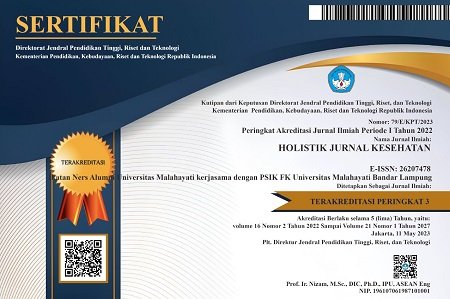Latihan fisik pada anak penderita asma: Studi literatur
Abstract
Background: Physical exercise in children with asthma is very important, but the negative perception that there will be a recurrence of asthma attacks after physical exercise makes them reluctant to do physical exercise. This has a negative impact on fitness which will cause the rate of recurrence of asthma to increase so there will be an increase in the number of emergency management and hospitalizations, followed by poorly attended rates in school, and decreased productivity.
Purpose: To synthesize existing research on various physical exercises in children with asthma.
Method: This literature design uses a narrative review method. Search for articles specified in Indonesian, namely "Latihan Fisik" AND "Anak" AND "Asma". And for the English article, namely "Physical Exercise" AND "Children" AND "Asthma".
Results: Finding 10 articles that were identified and relevant to the purpose of the study. The result of the literature study illustrated that there were several physical exercises that were applied by children with asthma as non-pharmacological therapy, including physical exercise swimming, active play, cycling/static cycling, HIIT aerobic physical exercise, treadmill, and indoor physical exercise (low intensity: walking, flexibility, coordination/relaxation High intensity: running, weight training with companion/sports team).
Conclusion: All articles showed that physical exercise could maintain body fitness, could improve asthma control, and could improve the quality of life of children with asthma. This literature study is to be used as an information and educational content in nursing interventions on asthma management in children.
Keywords: Asthma; Children; Physical exercise
Pendahuluan: Latihan fisik pada anak penderita asma sangat penting, namun adanya persepsi negatif akan adanya kekambuhan serangan asma setelah latihan fisik membuat enggan melakukan latihan fisik. Hal tersebut berdampak negatif pada kebugaran tubuh yang akan menyebabkan angka kekambuhan asma meningkat sehingga akan terjadi peningkatan angka penanganan gawat darurat dan rawat inap, angka absensi anak disekolah meningkat dan menurunkan produktivitas.
Tujuan: Untuk mensintesis penelitian yang telah ada mengenai berbagai latihan fisik pada anak penderita asma.
Metode: Desain literatur ini menggunakan metode narrative review. Pencarian artikel yang ditentukan dalam Bahasa Indonesia yaitu “Latihan Fisik” DAN “Anak” DAN “Asma”. Dan untuk artikel Bahasa Inggris yaitu “Physical Exercise” AND “Children” AND “Asthma”.
Hasil: Didapatkan 10 artikel yang teridentifikasi dan relevan dengan tujuan penelitian. Hasil studi literatur menggambarkan terdapat beberapa latihan fisik yang bisa dilakukan oleh anak penderita asma sebagai terapi nonfarmakologis, diantaranya ada latihan fisik berenang, bermain aktif, bersepeda/bersepeda statis, latihan fisik aerobic HIIT, treadmill dan latihan fisik didalam ruangan (intensitas rendah: berjalan, fleksibilitas, koordinasi/relaksasi. Intensitas tinggi : berlari, latihan beban dengan pendamping/olahraga tim).
Simpulan: Dari semua artikel menunjukkan bahwa dengan latihan fisik dapat menjaga kebugaran tubuh, dapat meningkatkan kontrol asma serta dapat meningkatkan kualitas hidup anak penderita asma. Studi literatur ini diharapkan dapat dijadikan informasi dan muatan edukasi dalam intervensi keperawatan pada manajemen asma pada anak.
Keywords
References
Ahmad, H. I. (2009). Efektivitas Olahraga Pernapasan Terhadap Penurunan Gejala Asma. Idea Nursing Journal, 117–126.
Al-Akour, N., & Khader, Y. S. (2008). Quality of life in Jordanian children with asthma. International Journal of Nursing Practice, 14(6), 418–426. https://doi.org/10.1111/j.1440-172X.2008.00715.x
Andrade, L. B. De, Britto, M. C. A., Lucena-Silva, N., Gomes, R. G., & Figueroa, J. N. (2014). The efficacy of aerobic training in improving the inflammatory component of asthmatic children. Randomized trial. Respiratory Medicine, 108(10), 1438–1445. https://doi.org/10.1016/j.rmed.2014.07.009
Baranowski, T., Abdelsamad, D., Baranowski, J., O’Connor, T. M., Thompson, D., Barnett, A., & Chen, T. A. (2012). Impact of an active video game on healthy children’s physical activity. Pediatrics, 129(3). https://doi.org/10.1542/peds.2011-2050
Dantas, F. M. N. A., Correia, M. A. V., Silva, A. R., Peixoto, D. M., Sarinho, E. S. C., & Rizzo, J. A. (2014). Mothers impose physical activity restrictions on their asthmatic children and adolescents: An analytical cross-sectional study. BMC Public Health, 14(1), 1–7. https://doi.org/10.1186/1471-2458-14-287
Departemen Kesehatan Republik Indonesia. (2013). Hasil Riset Kesehatan Dasar Tahun 2013. Diakses pada tanggal 16 November 2019 dari http://depkes.go.id/downloads/riskesdas.pdf Departemen Kesehatan Republik Indonesia. (2018). Hasil Riset Kesehatan Dasar Tahun 2018. Diakses pada tanggal 16 November 2019 dari http://depkes.go.id/downloads/riskesdas.pdf
Dharmayanti, I., Hapsari, D., & Azhar, K. (2015). Asma pada anak Indonesia: Penyebab dan Pencetus. Kesmas: National Public Health Journal, 9(4), 320. https://doi.org/10.21109/kesmas.v9i4.738
Dimitrakaki, V., Porpodis, K., Bebetsos, E., Zarogoulidis, P., Papaiwannou, A., Tsiouda, T., & Zarogoulidis, K. (2013). Attitudes of asthmatic and nonasthmatic children to physical exercise. Patient Preference and Adherence, 7, 81–88.
Eijkemans, M., Mommers, M., Draaisma, J. M. T., Thijs, C., & Prins, M. H. (2012). Physical Activity and Asthma: A Systematic Review and Meta-Analysis. PLoS ONE, 7(12). https://doi.org/10.1371/journal.pone.0050775
Fanny, P. A. (2018). Gambaran Karakteristik Tingkat Kontrol Penderita Asma Berdasarkan Indeks Massa Tubuh (IMT) Di Poli Paru RSup. Dr. M. Djamil Padang Pada Tahun 2016 (Doctoral dissertation, Universitas Andalas).
Gomes, E. L. F. D., Carvalho, C. R. F., Peixoto-Souza, F. S., Teixeira-Carvalho, E. F., Mendonça, J. F. B., Stirbulov, R., & Costa, D. (2015). Active video game exercise training improves the clinical control of asthma in children: Randomized controlled trial. PLoS ONE, 10(8), 1–11. https://doi.org/10.1371/journal.pone.0135433
Haines, M. S., & Kim, D. H. (2013). A Study of the Effects of Physical Activity on Asthmatic Symptoms and Obesity Risk in Elementary School-Aged Children. American Journal of Health Education, 44(3), 156–161. https://doi.org/10.1080/19325037.2013.779905
Hari, A. E., Roni, N., & Agung, W. T. (2010). Paparan Asap dalam Rumah, Hewan Peliharaan, Lingkungan Tempat Tinggal dan Sosial Ekonomi dengan Kejadian Asma Bronkial pada Anak. Berita Kedokteran Masyarakat, 26(3), 125-131.
Hockenberry, M.J & Wilson, D. (2013). Wong’s Essential of Pediatric Nursing. St. Louis Missoury: Mosby.
Kartikasari, D., Jenie, I. M., & Primanda, Y. (2019). Latihan Pernapasan Diafragma Meningkatkan Arus Puncak Ekspirasi (Ape) Dan Menurunkan Frekuensi Kekambuhan Pasien Asma. Jurnal Keperawatan Indonesia, 22(1), 53–64. https://doi.org/10.7454/jki.v22i1.691
Kapti, R. E., & Azizah, N. (2017). Perawatan Anak Sakit di Rumah. Universitas Brawijaya Press.
Kementerian Kesehatan Republik Indonesia. (2019). Profil Penyakit Tidak Menular Tahun 2019. Diakses pada tanggal 16 November 2019 dari http://p2ptm.kemkes.go.id/infographic-p2ptm/paru-obstruktif-kronik-dan-gangguan-imunologi/definisi-asma
Kurniawan, S. T., Ghoni, A., Rahmawati, I., & Suryandari, D. (2018). Pengaruh senam asma indonesia terhadap kontrol asma pasca penderita asma di balai besar kesehatan paru masyarakat (BBKPM) Surakarta. Motorik Jurnal Ilmu Kesehatan, 13(27).
Latorre-Román, P. Á., Navarro-Martínez, A. V., & García-Pinillos, F. (2014). The effectiveness of an indoor intermittent training program for improving lung function, physical capacity, body composition and quality of life in children with asthma. Journal of Asthma, 51(5), 544–551. https://doi.org/10.3109/02770903.2014.888573
Lu, K. D., Cooper, D. M., Haddad, F., & Radom-Aizik, S. (2018). Four months of a school-based exercise program improved aerobic fitness and clinical outcomes in a Low-SES population of normal weight and overweight/obese children with asthma. Frontiers in Pediatrics, 6(December), 1–8. https://doi.org/10.3389/fped.2018.00380
Maulani, M. (2014). Latihan Sepeda Statis Meningkatkan Peak Expiratory Flow (PEF) dan Mengurangi Frekuensi Kekambuhan pada Penderita Asma. IJNP (Indonesian Journal of Nursing Practices), 1(1), 55–61.
Nugraheni, D., Rima Agustin, W., & Nur Fitriana, R. (2015). Peran Perawat Tentang Penanganan Asma Pada Anak di IGD Puskesmas Sibela Mojosongo Surakarta. Bachelor Program In Nursing Science Kusuma Husada Health Science College Of Surakarta, 48, 1–15. https://doi.org/10.4135/9781849209403.n73
Onur, E., Kabaroĝlu, C., Günay, Ö., Var, A., Yilmaz, Ö., Dündar, P., & Yüksel, H. (2011). The beneficial effects of physical exercise on antioxidant status in asthmatic children. Allergologia et Immunopathologia, 39(2), 90–95. https://doi.org/10.1016/j.aller.2010.04.006
Paré, G., & Kitsiou, S. (2017). Methods for literature reviews. In Handbook of eHealth Evaluation: An Evidence-based Approach [Internet]. University of Victoria.
Prem, V., Sahoo, R. C., & Adhikari, P. (2013). Effect of diaphragmatic breathing exercise on quality of life in subjects with asthma: A systematic review. Physiotherapy Theory and Practice, 29(4), 271–277.
Putri, P. P., Nisa, K., & Wahyudo, R. (2018). Program Olahraga Renang: Intervensi Non-Farmakologis yang Efektif pada Asma Anak. Jurnal Medula, 7(5), 37-41.
Rahayu, T., Syafril, S., Suardi Wekke, I., & Erlinda, R. (2015). Teknik Menulis Review Literatur Dalam Sebuah Artikel Ilmiah. Metrologia, 53(5), 1–116.
Rulianto, G., Safari, I., & Mulyanto, R. (2016). Pengaruh Olahraga Renang Gaya Dada Sebagai Hydro Therapy Terhadap Penurunan Intensitas Kambuh Pada Penyakit Asma (Penelitian Eksperimen pada Siswa. Ejournal.Upi.Edu, 1(1), 80–85. Retrieved from http://ejournal.upi.edu/index.php/SpoRTIVE/article/view/3486
Udin, M. F. (2019). Buku Praktis Penyakit Respirasi pada Anak untuk Dokter Umum. Universitas Brawijaya Press.
Usman, I., Chundrayetti, E., & Khairsyaf, O. (2015). Faktor Risiko dan Faktor Pencetus yang Mempengaruhi Kejadian Asma pada Anak di RSUP Dr . M . Djamil Padang. Jurnal Fakultas Kedokteran Unand, 4(2), 392–397. Retrieved from www.google.scholar.com
Wang, J. S., & Hung, W. P. (2009). The effects of a swimming intervention for children with asthma. Respirology, 14(6), 838–842. https://doi.org/10.1111/j.1440-1843.2009.01567.x
Westergren, T., Fegran, L., Nilsen, T., Haraldstad, K., Kittang, O. B., & Berntsen, S. (2016). Active play exercise intervention in children with asthma: A PILOT STUDY. BMJ Open, 6(1), 1–9. https://doi.org/10.1136/bmjopen-2015-009721
Wicher, I. B., O, M. Â. G. de O., Marmo, D. B., Santos, C. I. da S., Toro, A. A. D. C., Mendes, R. T., & Ribeiro, J. D. (2010). Effects of swimming on spirometric parameters and bronchial hyperresponsiveness in children and adolescents with moderate persistent atopic asthma. Jornal de Pediatria, 0(0), 384–390. https://doi.org/10.2223/jped.2022
Wijaya, I. M. K. (2015, October). Aktivitas Fisik (Olahraga) Pada Penderita Asma. In Prosiding Seminar Nasional MIPA. Latorre-Román, P. Á., Navarro-Martínez, A. V., & García-Pinillos, F. (2014). The effectiveness of an indoor intermittent training program for improving lung function, physical capacity, body composition and quality of life in children with asthma. Journal of Asthma, 51(5), 544–551. https://doi.org/10.3109/02770903.2014.888573
Winn, C. O. N., Mackintosh, K. A., Eddolls, W. T. B., Stratton, G., Wilson, A. M., McNarry, M. A., & Davies, G. A. (2019). Effect of high-intensity interval training in adolescents with asthma: The eXercise for Asthma with Commando Joe’s® (X4ACJ) trial. Journal of Sport and Health Science, 00. https://doi.org/10.1016/j.jshs.2019.05.009
Zainoel, R., & Banda, A. (2014). Hubungan Tingkat Pengetahuan Pasien Asma Dengan Tingkat Kontrol Asma Di Poliklinik Paru Rsud Dr. Zainoel Abidin Banda Aceh. Jurnal Kedokteran Syiah Kuala, 14(3), 139–145.
DOI: https://doi.org/10.33024/hjk.v15i3.4663
Refbacks
- There are currently no refbacks.
Copyright (c) 2021 Holistik Jurnal Kesehatan

This work is licensed under a Creative Commons Attribution-NonCommercial 4.0 International License.














